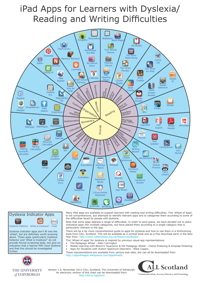 Mobile devices, such as the iPad, iPhone and Android tablets have had a major impact on society over the last decade. iPads are now being used increasingly in teaching and learning, and in therapy and rehabilitation to support learners with additional support needs.
Mobile devices, such as the iPad, iPhone and Android tablets have had a major impact on society over the last decade. iPads are now being used increasingly in teaching and learning, and in therapy and rehabilitation to support learners with additional support needs.
Take a look at some of our resources about iPads:
The CALL Blog has regular posts on iPads
iPad short guides to support reading and writing (video playlist)
A complete beginner's guide to the iPad (poster)
Using the iPad to support learners with physical difficulties (poster)
Using the iPad to support learners with visual difficulties (poster)
iPads for Communication, Access, Literacy and Learning (book) - iCALL provides a useful introduction to the use of iPads in schools. It can be downloaded without charge, while printed copies can be purchased from the CALL Shop.
Advantages and Disadvantages
iPads have many attractions:
- they are small and light, making them easy for a small child to use.
- there are thousands of enjoyable, low cost (or free) interactive apps that can engage the user.
- they are fast to turn on - no waiting for a couple of minutes to boot up, like a laptop.
- the built-in camera can be used to create instant personal resources.
- they are mainstream devices that have the 'cool' factor and are very motivating.
On the other hand, there are potential drawbacks:
- media hype, particularly with regard to use with people with autism, can lead to unrealistic expectations of success. Parents may ask for iPads for their children with additional support needs when other solutions may be more appropriate.
- they can be difficult for people with some physical disabilities to use although this has much improved now that USB and Bluetooth keyboards and mice can be used on an iPad.
- there can be issues with accessing wifi networks in some schools and other institutions.
- poor integration between apps can make some tasks more complicated than they would be on a computer.
- printing can be awkward in schools.
iPads in Schools
Teachers and pupils in some schools and local authorities are already using iPads, sometimes just as individuals, but increasingly as part of an organised introduction of new technology. At the time of writing in January 2022, the City of Glasgow, Falkirk and Scottish Borders Councils are issuing iPads to every learner in primary 6 and above and City of Edinburgh is planning a similar roll-out. However, we hear from educators and parents that the apps available are restricted and that it seems difficult to install special apps that are needed for learners with additional support needs.
The Apple Education web site offers an overview and resources to support teachers.
The simplicity of iPads means that they can be very accessible for learners with additional support needs; they can provide an affordable option for some learners who require a voice output communication aid; while a study of technologies used by learners with visual impairment in Scotland published in 2020 found that iPads were the most commonly used type of tablet by learners with visual impairment.
iPads have good built-in Accessibility options - find out more at the Apple Accessibility website.
Finding the Right App

There are many thousands of apps available for use in education, but it can be difficult to find the app that suits the learner and the learning activity. The iTunes Preview web site provides a list of apps in many categories, but it can be very difficult to find an app unless you know exactly what you want.
We have published some popular 'wheels of apps' which give a visual representation of some of the apps that we have found useful.
iPad apps for complex communication needs (Wheel of Apps poster)
iPad apps for learners with complex additional support needs (Wheel of Apps poster)
iPad apps for learners with dyslexia (Wheel of Apps poster)
iPad apps to support creativity (poster)
Using the iPad to support dyslexia (Wheel of Apps poster)
The information on the Spectronics blog is helpful for identifying apps for individual learners with additional support needs, with their iPhone / iPad Apps for AAC, Apps for Early Literacy list and Apps for Literacy Support site, being particularly good. More sites with lists of apps are included in our Resources and Further Information handout listed below.
Finding Out More
OT's with Apps & Technology - from an Occupational Therapy perspective.
Resources and Further Information on the iPad - PDF handout with list of web-based resources on iPads and apps.
CALL Training - CALL Scotland provides regular courses on different aspects of the use of iPads. Training can also be provided in your centre.
 Mobile devices, such as the iPad, iPhone and Android tablets have had a major impact on society over the last decade. iPads are now being used increasingly in teaching and learning, and in therapy and rehabilitation to support learners with additional support needs.
Mobile devices, such as the iPad, iPhone and Android tablets have had a major impact on society over the last decade. iPads are now being used increasingly in teaching and learning, and in therapy and rehabilitation to support learners with additional support needs.


Our social media sites - YouTube, Twitter and Facebook